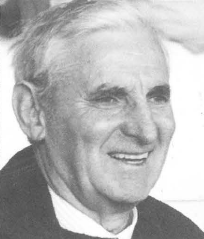Tony Reddin Wins Knocknagow Award
Tipperary GAA Yearbook 1998, p 105
ONE of the highlights of the Cidona Sports Awards in the Clonmel Arms Hotel on January 24 was the presentation of the Knocknagow Award to Tony Reddin, the former Lorrha and Tipperary goalkeeper. Tony won All-Ireland senior medals in 1949, 50 and 51 and his outstanding performances between the posts during these and later years were sufficient to win him membership of the Team of the Century in 1984. To the strains of the band playing the county anthem, 'Slievenamon', and the cheers of the three hundred people present at the ceremony, Tony strode up to be presented with his award.
Tony Reddin
Born in Mullagh, Co. Galway in 1920, Tony came to work in Lorrha in February 1947. He had a hurling record before he crossed the Shannon. He won a county juvenile medal with Mullagh in 1933 and a divisional junior medal in the late thirties. He played county junior hurling in 1940 when Galway were beaten by Cork in the All-Ireland. Graduating to senior ranks in 1941 he played on the Connaght Railway Cup team that was trounced by Munster that year. He didn' t appear for
Galway again until 1946 . In that year he played full-forward in the Monaghan Cup game at London against Tipperary. Playing full-forward for Tipperary that day was Tony Brennan.
He made his debut with Lorrha in a tournament game against St. Vincent's of Dublin on Easter Sunday 1947. He played unspectacularly with his new club in the championship. The following year he made his name as a goalkeeper, particularly against Borrisoleigh in the divisional final. As a result he was drafted on to the county panel for the 1948-49 league and was to be a regular on the team until 1956. After that he rotated with Blackie Keane until he played his final game for
the county at New York in October 1957.
In an article on Reddin in his Lorrha club history, Seamus King wrote thus about him:
"Why was Reddin so brilliant? Many people remember him as a big man going high for the ball, catching it securely and bursting out amid a welter of hurleys, to clear well up the field. It will come as a surprise to learn that Tony is not a big man. He stands 5'9" and, at the height of his career in the early fifties , never weighed more than eleven and a half stone! He was a very fit man. He trained for the position as keenly as another might train for centrefield. Running crosscountry, jumping over hedges and ditches and building up his arms made him the strong player he was. He had the eye of a hawk, some might even say of compensatory quality for defects in his oral and aural senses. Neighbours have commented on how sharp that eyesight was and is in spotting someone at a distance. He was no mere ball stopper but a player who completed the act by clearing the ball down the field. He was equally good on the right or the left side and this again came from constant practice. He sharpened his reflexes by belting a ball against a rough stone wall from shot distances and catching the ball in his hand as it rebounded in different directions. Probably his greatest ability was a sensitive touch allied with the tilting of the hurley's face at an angle, which enabled him to kill even the fastest ball dead so that it rolled down the hurley into his hand as if by the genius of a master magician. Finally, Tony used no 'half-door' of a hurley to stop the ball . His was of ordinary size and he had the same stick for most of his hurling career, a heavy, many hooped, ugly-looking affair.
